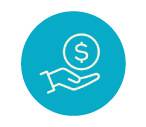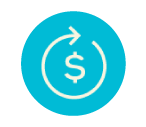How does Education
Savings work?
The RESP is easy to use and offers many advantages, thanks to your contributions and generous government grants. In fact, your contributions, big and small, grow quickly in a registered education savings plan.
What is an RESP?
A registered education savings plan is designed to help you save for a child’s post-secondary education. It also allows you to achieve your financial goals more easily, as you’ll receive up to $12,8001 government grants per beneficiary on top of your contributions. Over time, your savings and the money invested by the government will grow tax-free.

The ratios used are not representative of reality and are for information purposes only.
What does an RESP account consist of?
An RESP is divided into three parts:
- Contributions made by the subscriber (the person who opened the RESP).
- Generous government grants that enhance the contributions.
- Income that accumulates over time.
When the student enters post-secondary education, the contributions can be withdrawn tax-free by the person who opened the RESP. The subscriber may withdraw the contributions at their own pace and either give them to the student, invest them for retirement, or keep the money for other purposes.
Grants and all accumulated income constitute education assistance payments (EAPs) and are paid to the student to finance their post-secondary education, provided they are enrolled in an eligible program2 (a vocational program, an AEC, a DEC, a technical program, or a university program), here or elsewhere in the world.
What are the RESP steps?
Baby on the way or already here! You can start thinking about your child's future now by opening an RESP. All you need is the child's Social Insurance Number (SIN).

RESP opening
This is when you set up your education savings plan.
Our representatives know RESPs inside and out. They can help you choose the right plan for your family.

RESP contributions
Have you chosen how long you want to save? 2 years? 5 years? 10 years, or more?
Do you prefer the peace of mind of preauthorized monthly contributions? Or perhaps annual payments4 are better suited to you?
Once you decide, you’re all set. Now it’s up to you to contribute!

Grants and returns
As your child grows, so does your RESP! Your contributions add up quickly and generate earnings of their own.
And don’t forget, you’ll receive government grants on top of your investment. Your child could receive up to $12,800 in grants!1

Post-secondary education on the horizon
Your beneficiary is embarking on a new phase of life: post-secondary education2!
They can now start receiving educational assistance payments (EAPs), depending on the terms of your RESP. EAPs include the grant money in your plan as well as the income earned on both the grants and your savings.

Refund of contributions
Time to reap the rewards!
Now that your contract has reached maturity, you can access all (or a portion) of the contributions you’ve made over the years.5
You can use this money however you see fit, without paying tax on it.
Remember that to ensure your beneficiary can receive the grant money accumulated for them, you need to provide the government with proof of enrolment in an eligible post-secondary program.2
It all depends on which type of RESP you open.
With our IDEO+ line of RESPs (Conservative, Adaptive, and Responsible), you decide how much to contribute and how often from among the options available. You can choose to make monthly or one-time contributions.4
To find out which product is best suited to your situation, talk to one of our representatives.
No, Kaleido takes care of everything! Once your RESP is open, Kaleido will apply for the grants on your behalf. Your representative will have you sign the required forms when you sign the contract.
Just be sure to send us your Social Insurance Number (SIN) and the SIN of your beneficiary via your Client Space. This is essential to receive the grants your child is entitled to and to keep your RESP active.
No, unfortunately that’s not possible.
The child (or beneficiary) must be a Canadian resident at the time the RESP is opened and while contributions are being made. This is a legal requirement under Canada’s Income Tax Act.
As planned, you will receive a refund of your contributions at plan maturity,5 even if your child doesn’t pursue post-secondary education.
You can also choose one of the following options, under certain conditions6:
- Transfer the RESP to another child
- Transfer the accumulated income to an RRSP
- Cash in your accumulated income (through accumulated income payments)
Yes. Educational assistance payments can be used to cover tuition and all other education-related expenses, such as housing, school supplies, computer equipment, food, transportation, car expenses, and more.
Do you have questions about RESPs?

Interested in reaping the benefits of an RESP?
Talk to one of our education savings professionals!
1. Canada Education Savings Grant (CESG) of 20% to 40% and Quebec Education Savings Incentive (QESI) of 10% to 20%. Based on adjusted family net income. The annual limit is $600 for the CESG and $300 for the QESI. The lifetime limit per beneficiary is $7,200 for the CESG and $3,600 for the QESI. Canada Learning Bond (CLB) of up to $2,000 per beneficiary, for children born to financially eligible families after December 31, 2003. Certain conditions apply. See our prospectus at kaleido.ca.
2. Certain conditions apply. Refer to the prospectus for the list of eligible studies at kaleido.ca.
3. The results presented are for illustrative purposes only and do not guarantee the future performance of the chosen IDEO+ plan.
4. Subject to the minimum amounts required for the first contribution and subsequent deposits. See contribution options in our prospectus at kaleido.ca.
5. Savings invested in treasury bills, government bonds, and high-quality companies. Refund of contributions is subject to investment risk. Certain conditions apply. See our prospectus at kaleido.ca.
6. Certain conditions apply. See our prospectus at kaleido.ca.
